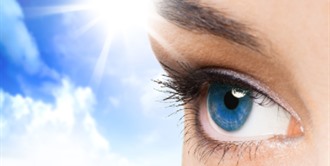Just like our skin, our eyes can suffer from sun damage too. UVA and UVB light rays can enter the eye and wreak havoc causing a number of conditions and growths which over time can affect our vision and eye health.
Conditions and Growths Caused by UV Damage to the Eyes ;
Cataracts – Researchers have found that UV is one of the major culprits that lead to cataract development, the most common cause of vision loss in people over the age of 40. Cataracts slowly develop and at first have little effect on our vision but as the natural lens in the eye becomes cloudy the vision becomes more and more hazy and blurred.
Photokeratitis or better known as “Snow Blindness” is caused by the cornea being sunburnt, and not necessarily on the ski slopes. This is a very painful condition where the eyes feel like they are burning, they have a gritty sensation, are red and the lids often swell. Temporary loss of vision can occur but returns in 24 to 48 hours.
Sun damage is one of the contributing factors to Age Related Macular Degeneration. This is when the macular becomes damaged. The macular has the highest density of visual cells that gives the sharpest part of your vision. These cells are respond to light so signals are transmitted to the brain so it can determine what you are looking at. This damage in turn affects the central vision -what you can see directly in front of you.
Growths such as Pingueculae and Pterygia are non cancerous, however can grow on the white part of the eye. These growths look unsightly, can cause discomfort and eventually will distort the vision.
The external and internal parts of the eyes are targets for sun cancers and if not detected early can lead to serious consequences.
Protecting the eyes from UV
Sunglasses are the obvious defence and it is important that you choose sunglasses that meet the Australian Standard AS1067:2003 and feature lens categories of 2, 3 or 4 and an EPF factor of 9 or 10 which should be on the tag attached to the sunglasses when your purchase them. Be aware if sunglasses do not have a tag with Australian Standard details they are possibly only fashion sunglasses offering no protection.
Interestingly, the darkness of the lens is not an indicator of the level of UV protection as a tint offers no protection apart from reducing the glare, the UV protective coating on the lens is clear.
When choosing a sunglasses the ideal design is a large wrap around as it reduces the UV rays that sneak in around the frame and bounce off the inside of the lens into your eyes. If a wrap around sunglass isn’t your style a sunglass that features a multi- coating on both sides of the sunglass lens is the best defence as it absorbs UV and stops the reflected glare. Maui Jim sunglasses are well known for this feature however there are other brands that also have the multi-coating on both sides of the lens. A broad brimmed hat also will help to reducing those sneaky UV rays that get through the sides of your sunglass frame.
Living in Australia we all suffer effects of sun damage to the eyes, it’s unavoidable. Having a regular eye check should also be part of your eye care protection routine, even if you feel your vision is fine. During a consultation your eye care professional will not only access your vision but they will check and monitor the health of your eyes too, keeping you informed of any deterioration or issues which can be addressed early.
Contact Lenses & UV Protection
Contact lens wearers have the ability to add an extra layer of protection against UV to their eyes as many contact lenses feature protective UV blocking filters. However, there are varying levels of protection and like sunglasses, contact lenses have classifications. Class 1 is awarded to those contact lenses that block 90% of UV-A and 99% of UV-B, contact lenses that fall into this class are Acuvue Trueye and Acuvue Oasys and Acuvue Oasys for Astigmatism.
Class 2 is awarded to contact lenses that block 70% of UV-A and 95% of UV-B, contact lenses that are in Class 2 include Cooper Vision’s Avaira lenses, Alcon’s Freshlook range and Acuvue Moist.
Other contact lenses offer some degree of UV protection but do not meet the ratings of Class 1 or 2.

